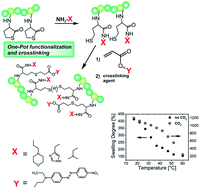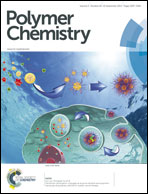Synthesis of multi-functionalized hydrogels by a thiolactone-based synthetic protocol†
Abstract
We established a simplified synthetic protocol for the preparation of multiple functionalized hydrogels, which is potentially employable for the fabrication of adaptable sensors, using the recently introduced thiolactone chemistry. Thiolactone groups can be opened with a primary amine, through which a functional group is introduced, while at the same time a thiol is released, which is available for crosslinking or further functionalization. In this respect, a thiolactone functionalized poly(N-isopropylacryl amide) (p(NIPAAm-co-TlaAm)) precursor, obtained via RAFT, and 3-morpholinopropylamine or histamine as the ring opening amines are used to synthesize gels responding to CO2. The synthetic protocol relies on a newly discovered crosslinking mechanism involving the solvent dichloromethane as the crosslinking agent. We discuss the gel formation protocol in detail, including the crosslinking mechanism, and additionally demonstrate the response of the synthesized gels towards CO2. Finally, we show how the applied synthetic protocol can be used for the preparation of multiple functionalized gels, extending the concept to optical response type gels.


 Please wait while we load your content...
Please wait while we load your content...